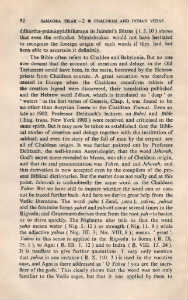Page 740 - Lokmanya Tilak Samagra (khand 2)
P. 740
92 SAMAGRA TILAJ:. - 2 • CHALDEAN AND INDIAN VEDAS
ddhartha-prama~yadhikara~a in Jaimini's Sutras ( i. 3. 10 ) shows
that even the orthodox Mimamsakas would not have hesitated
to recognise the foreign origin of such words if they had but
ken able to ascertain it definitely.
The Bible often refers to Chaldea and Babylonia. But no one
1ver dreamt that the account of creation and deluge in the Old
Testament could have been, in the main, borrowed by the Hebrew
priests from Chaldean sources. A great sensation was therefore
oaused in Europe when the Chaldean cuneiform tablets of
the creation legend were discovered, their translation published
and the Hebrew word T~hom, which is translated as 'deep' or
' waters ' in the first verses of Genesis, Chap. I, was found to be
ao other than Assyrian Tamtu or the Chaldean Tiamat. Even !lO
late as 1902, Professor Delitzsch's lectures on Babel and Bible
(Eng. trans. New York 1903) were received and criticised in the
same spirit. But it may now be taken as established that the Bibli-
cal stories of creation and deluge together with the institution of
sabbath and even the story of the fall of man by the serpent are
all of Chaldean origin. It was further pointed out by Professor
Delitzsch, the well-known Assyriologist, that the word Jehovah,
God's secret name revealed to Moses, was also of Chaldean origin,
and that its real pronunciation was Yahve, and not Jehovah; and
this derivation is now accepted even by the compilers of the pre-
sent Biblical dictionaries. But the matter does not really end at this
point. Jehovah is undoubtedly the same word as the Chaldean
Yahve. But we have still to inquire whether the word can or can-
not be traced further back. And here we derive great help from the
Vedic literature. The word yahu ( Zend, yazu ), yahva, yahvat
and the feminine forms yahv£ andyahvat£ occur several times in the
~igveda; and Grassmann derives them from the root yah= to hasten
or to drive quickly. The Nighaptu also tells us that the word
yaha means water ( Nig. I. 12 ) or strength ( Nig. 11. 9 ) while
the adjective yahva ( Nig. III. 3; Nir. VIII, 8 ); means 'great'.
Yahva in this sense is applied in the ~igveda to Soma ( ~. IX.
75. 1 ), to Agni ( R III. 1. 12) and to Indra ( ~. VIII. 13. 24 ).
It is needless to give further quotations. I may only mention
that yahva in one instance ( ~. X. 110. 3 ) is used in the vocative
case, and Agni is there addressed as' 0 Yahva ! you are the sacri-
ficer of the gods.' This clearly shows that the word was not only
familiar to the Vedic sages, but that it was applied by them to

